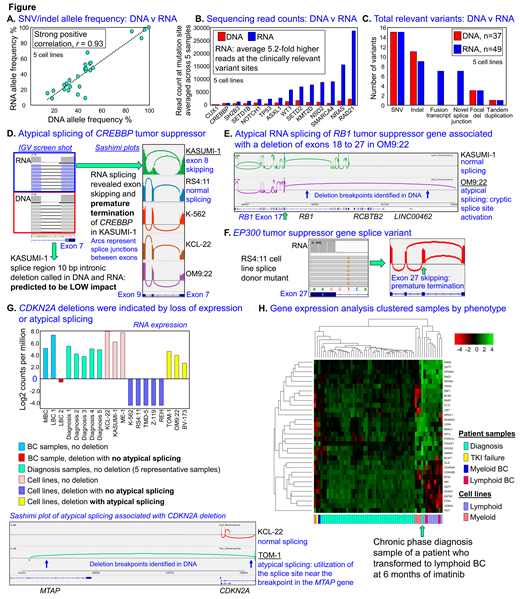Background
Mutation of genes linked to hematologic cancer have recently been reported in CML and are associated with early progression and resistance (Reviewed in Branford, Kim Leuk 2019). The mutations comprise single nucleotide variants (SNVs) and small insertions/deletions (indels), plus gene fusions and large focal gene deletions. In 39 patients (pts) in blast crisis (BC), all had at least 1 cancer gene mutation, including fusions in 33%: partner genes MLL, RUNX1, IKZF1, MECOM and CBFB. 50% of the fusions were novel and some were present at chronic phase diagnosis. BCR-ABL1 mutations rarely occurred as the sole mutant. NGS offers critical information for resistance assessment. For many clinical purposes, targeted DNA sequencing (seq) using panels of specific disease related genes is the most cost effective screening choice. However, this strategy could miss relevant fusions and deletions.
Aim
To determine whether an RNA based approach is more informative than DNA for detecting a broad range of mutations.
Method
A hybridization capture NGS gene panel was developed to target 126 genes relevant for myeloid/lymphoid leukemia. In a pilot study, DNA and RNA derived from 5 leukemia cell lines with well characterized mutations, including fusions and deletions, were panel sequenced. An additional 6 cell lines were sequenced using RNA, plus 49 pt samples with RNA stored for up to 14.6 years: 45 at diagnosis and 4 at BC/resistance. Six of these pt samples had prior whole exome and/or whole transcriptome seq. We used total RNA that detected intronic splice region variants from pre-spliced RNA. SNVs/indels were called from DNA/RNA with FreeBayes. Manta called focal deletions from DNA. Known and novel RNA fusions and novel splice junctions were detected using the STAR aligner. Gene expression used edgeR.
Results
For the 5 cell lines with DNA versus (v) RNA seq, SNVs/indels were reliably called in RNA, with a strong positive correlation of mutant allele frequency: DNA v RNA, r = 0.93. Two TP53 small deletions of 26 and 46 bp were not called in RNA, but were instead detected as novel RNA splice junctions. Read counts were 5.2 fold higher for RNA than DNA at sites of clinically relevant mutants, consistent with enrichment of seq read depth proportional to expression. Overall, RNA revealed a higher number of relevant mutants than DNA: RNA = 49 v DNA = 37, Fig A-C. Notably, the functional effect of splice region disrupting mutants and large focal deletions were evident by novel RNA splicing, Fig D-F.
In the total 11 cell lines tested with RNA, all 13 reported fusions were called, including BCR-ABL1 and RUNX1, MLL, ETV6 and CBFB fusions. For 7 cell lines with variants described in the COSMIC Cell Lines Project, 23/23 cancer gene SNVs/indels were called, plus 7 cancer gene SNVs/indels not reported. These were verified by DNA seq. 15 gene deletions were evident by atypical RNA splicing and verified by DNA seq: IKZF1, CDKN2A/B, PAX5, BTG1, RB1 and NCOR1. Five other cell lines had verified CDKN2A deletions that were evident by loss of gene expression, Fig G. Two BTG1 deletions were not detected.
For the 6 pt samples re-sequenced by the RNA panel, 8/8 verified fusion transcripts were detected with a 31 fold enrichment of read counts. 11/11 cancer gene SNVs/indels were called and 3/4 gene deletions. The exception was a CDKN2A deletion not detected by novel splicing but evident as loss of expression, Fig G. Seven other cancer gene SNVs were found at low allele frequency, including a resistant BCR-ABL1 mutation at 1.7% in the oldest sample.
Of the 43 diagnosis samples without prior NGS, BCR-ABL1 transcripts were detected in all. BCR-ABL1 genomic breakpoints were called at base pair resolution in 39, 91%. Two pts had mutated ASXL1 at diagnosis and both failed imatinib by 9 months with mutant BCR-ABL1. By gene expression analysis, all but 1 of the total 45 diagnosis samples clustered together. The exception was a pt who transformed to lymphoid BC at 6 months that clustered with the lymphoid cell lines and lymphoid BC pts, Fig H.
Conclusion
RNA gene panel seq demonstrated enhanced sensitivity and an increased yield of clinically relevant mutations compared with DNA panel seq. A single RNA assay has the capacity to detect SNV/indels, known and novel gene fusions, focal deletions and the likely functional effect of splice disrupting mutations. RNA panel seq is a valuable tool for the comprehensive assessment of mutations that drive CML treatment failure and drug resistance.
Branford:Novartis: Consultancy, Honoraria, Research Funding, Speakers Bureau; Bristol-Myers Squibb: Honoraria, Speakers Bureau; Qiagen: Consultancy, Honoraria; Cepheid: Consultancy, Honoraria. Shanmuganathan:Gilead: Other: Travel Support; Janssen: Other: Travel Support; Amgen: Other: Travel Support; Bristol-Myers Squibb: Honoraria, Other: Travel Support; Novartis: Honoraria, Other: Travel Support. Scott:Celgene: Honoraria. Hughes:Novartis, Bristol-Myers Squibb: Consultancy, Other: Travel; Novartis, Bristol-Myers Squibb, Celgene: Research Funding.
Author notes
Asterisk with author names denotes non-ASH members.


This feature is available to Subscribers Only
Sign In or Create an Account Close Modal